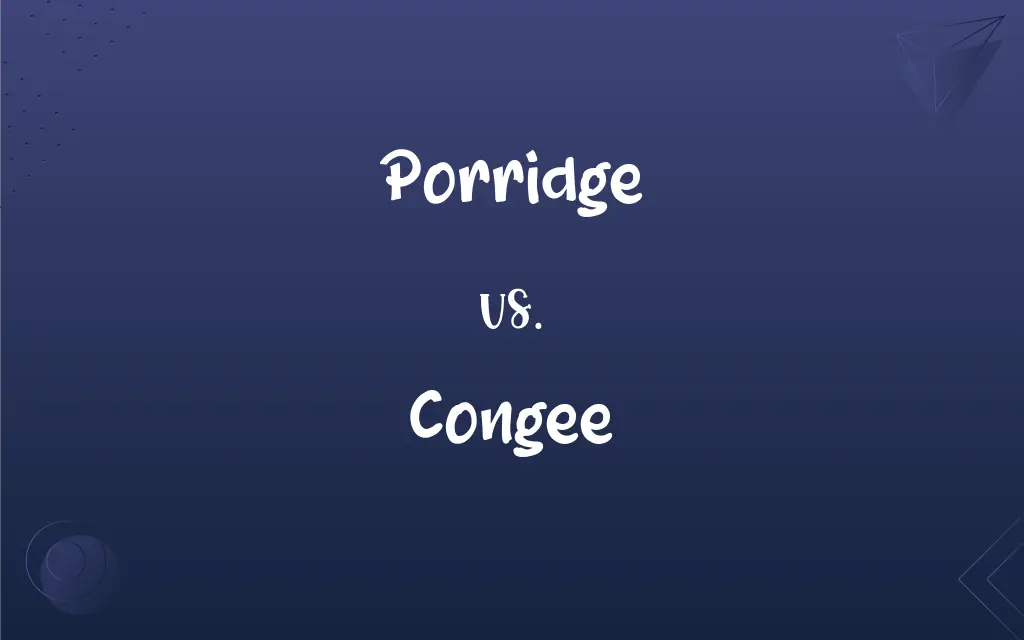Porridge vs. Congee: What's the Difference?
Edited by Aimie Carlson || By Janet White || Updated on October 11, 2023
Porridge is a dish made by boiling grains or legumes in milk or water, while congee is an Asian rice porridge cooked with a lot of water until very soft.

Key Differences
Porridge and congee are both dishes that involve boiling grains to create a thick, creamy consistency. The term "porridge" is more universal and can be used to describe any grain, such as oats, cornmeal, or barley, that has been boiled in water or milk. This process results in a hearty and often creamy dish. On the other hand, congee specifically refers to a type of rice porridge that is popular in many Asian cultures.
When considering ingredients, porridge can be quite versatile. Different grains or even legumes can be used, and it's often flavored with sweeteners like sugar, honey, or fruits. Contrarily, congee is primarily made from rice, often white rice, and it's cooked with a significant amount of water, leading to a very soft, almost soupy consistency. Congee can be either savory or sweet, with accompaniments ranging from meat and vegetables to sweet toppings.
Preparation time and consistency are also distinguishing factors between porridge and congee. While porridge, depending on the grain, can be prepared relatively quickly, congee usually requires a longer cooking time to break the rice grains down thoroughly. This extended boiling makes congee particularly soft and easily digestible, making it a common food for the elderly, sick, or those with digestive issues.
Regionally, porridge is a staple in many cultures around the world, from the oatmeal of Scotland to the maize-based "sadza" or "ugali" in Africa. Congee, meanwhile, has its roots in Asia, with variations found in China, Korea, India, and more. Each region might have its unique twist or ingredient set, but the basic preparation of boiling grains remains consistent.
Comparison Chart
Base Ingredient
Various grains or legumes
Primarily rice
ADVERTISEMENT
Texture
Varies, generally creamy
Very soft, often soupy
Flavor Varieties
Both sweet and savory
Both sweet and savory
Cooking Time
Varies based on grain
Usually longer for a softer texture
Regional Popularity
Worldwide
Primarily in Asia
Porridge and Congee Definitions
Porridge
A hot meal made by boiling grains in liquid.
For breakfast, she prepared a warm bowl of oat porridge.
ADVERTISEMENT
Congee
A watery rice dish often served with accompaniments.
The seafood congee was topped with fresh scallions.
Porridge
A soft food made by cooking cereal grains.
After his dental surgery, he mainly ate porridge.
Congee
Boiled rice with extended cooking for a mushy texture.
He added a dash of soy sauce to his morning congee.
Porridge
A mushy preparation of grains in liquid.
In cold weather, nothing beats a hearty porridge.
Congee
A soft rice preparation, often for the sick or elderly.
The baby's first solid food was a light congee.
Porridge
A thick and often creamy dish from boiled grains or legumes.
Cornmeal porridge is a favorite in Caribbean cuisine.
Congee
An Asian rice porridge cooked to a soft consistency.
When she was sick, her mother made her congee with chicken.
Porridge
Boiled starchy plants in water or milk.
Barley porridge has been enjoyed for centuries.
Congee
Rice boiled in excess water or broth until very soft.
At the hotel's breakfast buffet, there was a congee station.
Porridge
A soft food made by boiling oatmeal or another meal in water or milk.
Congee
Variant of congé.
Porridge
A dish made of grain or legumes, milk and/or water, heated and stirred until thick and typically eaten for breakfast.
Eat your porridge while it's hot!
Congee
A traditional Asian rice porridge.
Porridge
Oatmeal porridge.
Congee
Formal or authoritative permission to depart.
Porridge
Rice porridge; congee.
Congee
An abrupt dismissal.
Porridge
A prison sentence.
Just do your porridge and keep your head down.
Congee
A leave-taking.
Porridge
(rare) A type of thick soup or stew, especially thickened with barley.
Congee
A formal bow.
Porridge
A food made by boiling some leguminous or farinaceous substance, or the meal of it, in water or in milk, making of broth or thin pudding; as, barley porridge, milk porridge, bean porridge, etc.
Congee
(Architecture) A concave molding.
Porridge
Soft food made by boiling oatmeal or other meal or legumes in water or milk until thick
Congee
Leave, formal permission for some action, :
Congee
(obsolete) Formal permission to leave; a passport.
Congee
(obsolete) Formal dismissal; (figurative) any dismissal; originally & particularly humorously ironic abrupt dismissal without ceremony.
Congee
(obsolete) Formal leavetaking; (figurative) any farewell.
Congee
A fee paid to make another go away, (particularly) alms to a persistent beggar.
Congee
(archaic) A bow, curtsey, or other gesture (originally) made at departure but (later) including at greeting or in obeissance or respect.
Congee
A type of thick rice porridge or soup, sometimes prepared with vegetables and/or meat.
Congee
(archaic) To give congee, particularly
Congee
To give formal permission to leave; to dismiss.
Congee
To give formal permission to do something; to license.
Congee
(archaic) To take congee: to leave ceremoniously.
Congee
(archaic) To make a congee: to bow, curtsey, etc., while leaving; (figuratively) to make obeissance, show respect, or defer to someone or something.
Congee
See Congé, Conge.
And unto her his congee came to take.
Congee
Boiled rice; rice gruel.
Congee
A jail; a lockup.
Congee
A Chinese rice gruel eaten for breakfast
Congee
Depart after obtaining formal permission;
He has congeed with the King
Congee
Perform a ceremonious bow
FAQs
Is congee exclusive to Asian cuisine?
While congee has Asian origins, its popularity has spread globally.
What gives congee its soft texture?
Congee is cooked with a lot of water for an extended time, breaking down the rice.
Is oatmeal a type of porridge?
Yes, oatmeal is porridge made specifically from oats.
What grains can be used to make porridge?
Porridge can be made from oats, barley, cornmeal, and more.
How is porridge typically served?
Porridge is usually served hot, often with toppings or mix-ins.
Can porridge be dairy-free?
Yes, porridge can be made with water or non-dairy milk alternatives.
Can congee be made with brown rice?
Yes, brown rice can be used for congee, but the texture and taste will differ.
Are there health benefits to eating congee?
Congee is easily digestible and can be nutrient-rich based on its accompaniments.
How long does it take to cook congee?
It varies but often takes several hours for a soft, broken-down consistency.
Can porridge be flavored?
Yes, porridge can be sweetened with fruits, honey, or made savory with spices.
Can I add meat to congee?
Absolutely! Chicken, pork, and seafood are popular congee add-ins.
Can porridge be refrigerated?
Yes, porridge can be stored and reheated, though the texture may change slightly.
Are there cultural variations of congee?
Yes, many Asian countries have their unique variations and names for congee.
Can I make porridge with legumes?
Yes, legumes like lentils can be boiled into a porridge-like consistency.
Which is creamier, porridge or congee?
It varies, but porridges often have a creamier texture, while congee is more watery.
Is grits a form of porridge?
Yes, grits, made from cornmeal, is a type of porridge popular in the Southern U.S.
Can I make porridge in a slow cooker?
Yes, many grains for porridge can be cooked in a slow cooker for convenience.
Is congee always savory?
No, congee can be either savory or sweet, depending on the ingredients.
Why is congee often given to the sick?
Its soft texture and easy digestibility make congee ideal for those feeling unwell.
Are there quick-cook versions of congee?
Yes, some recipes or instant mixes offer quicker cooking times for congee.
About Author
Written by
Janet WhiteJanet White has been an esteemed writer and blogger for Difference Wiki. Holding a Master's degree in Science and Medical Journalism from the prestigious Boston University, she has consistently demonstrated her expertise and passion for her field. When she's not immersed in her work, Janet relishes her time exercising, delving into a good book, and cherishing moments with friends and family.
Edited by
Aimie CarlsonAimie Carlson, holding a master's degree in English literature, is a fervent English language enthusiast. She lends her writing talents to Difference Wiki, a prominent website that specializes in comparisons, offering readers insightful analyses that both captivate and inform.































































